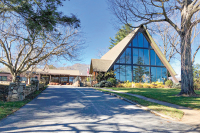The Language of Glass: World famous glass artist Joel Philip Myers brings impressive exhibit to WCU Fine Arts Museum
By Michael Beadle
On pedestals they stand. Whimsical arrangements of colored glass bottles, leaning, bending to resemble animated statues caught in the push and pull of conversation. These plastic forms look like baby bottles brought to life, acting out some street corner dance or a sitcom snapshot of physical comedy.
Welcome to the “Dialogue” series, part of the new art exhibit, “New Works: 1996-2000” from world-renowned glass artist Joel Philip Myers now on display through Dec. 16 at Western Carolina University’s new Fine Arts Museum in Cullowhee. The museum exhibit is free and open to the public.
Myers, a distinguished professor of art at Illinois State University, has exhibited his work in galleries all over the world including the Metropolitan Museum of Art in New York, the Hokkaido Museum of Modern Art in Japan, and the Musee Des Art Decoratifs in Paris.
In “New Works,” Myers stretches the boundaries of glass art by creating a series of bottles that tell stories, whether in playful clusters like the “Dialogue” series or in somber rows as with the work called “the dogs go on with their doggy life. And the torturer’s horse scratches its innocent behind on a tree.” (This title comes from lines in a W.H. Auden poem, “Musee des Beaux Arts.”)
With the “Dialogue” series, there’s a cause and effect at work, and the viewer wants to know what happened to put these figures in their poses. What causes them to tilt forward or sway or lean back? What force joins them or pulls them apart? Is it the wind, a fragrance, a fart, an inflammatory word, a whispered secret? The possibilities seem endless.
In “the dogs ...” the mood turns melancholy with two stark parallel rows of bottles. Initially we view the bottle colors as black versus white, but on closer inspection, the black appears charcoal — and not always uniformly black — while the white appears as an opaque crystal we might call a chalky, watery mix.
In this piece inspired by Auden’s poem about death going unnoticed, bottles are lined up like soldiers from opposing armies, or perhaps the silent monuments of their cemetery selves. These bottles are marred with battlefield scars inflicted from the outside and from within.
The left row (moving left to right) begins with 14 “white” bottles — seven pocked with small bullet holes followed by seven more cut with small shards of glassy shrapnel. The shards cut into the glass without breaking it and seem to grow into the skin of the glass. Continuing on this same row, the viewer will notice the wounds getitng bigger in the next 13 bottles — six with their tops ripped off followed by seven more with larger holes inflicted from the outside, holes that a finger or a tongue could fit through.
On the opposite row (again moving left to right), the “white” bottles have been punctured (or acupunctured?) with dozens of needles from various angles. Is this a continuation of torture or therapy after the war? Or is this a more specific, intentional pain inflicted by human fingers rather than a pipe bomb exploding its shrapnel? In the next sequence of seven “white” bottles, the glass loses noticeable punctures and weathers more subtle patterns, as if a thin layer of frost crystals had dried around the bottles. This pattern continues with seven more black bottles. In the final seven, black bottles show ugly, gaping holes that seem to blow up from within the bottle, as if the pressure, psychological anguish and torture inflicted upon these “soldiers” could not be held in anymore.
It’s important for art detectives to notice that while Myers shows a progression of “wounds” or experimental damage to these bottles, no two are the same in their experience, and no easy number pattern helps to simplify the exhibit. The soldier metaphor is but one way to look into the souls of these bottles. Whatever the story the viewer wishes to find, the glass undoubtedly speaks volumes about empathy, struggle, and endurance in the human experience.





